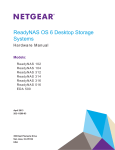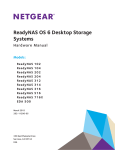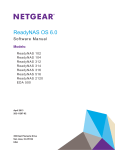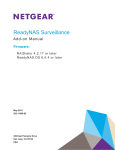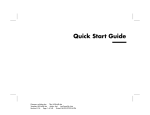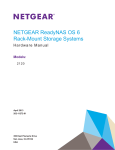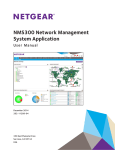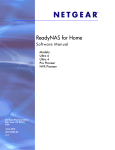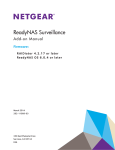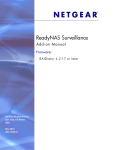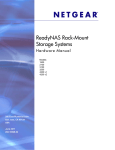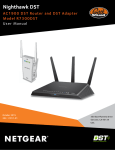Download Netgear Switch READYNAS 2120 User's Manual
Transcript
NETGEAR ReadyNAS OS 6 Rack-Mount Storage Systems Hardware Manual Models: R eadyNAS 2 12 0 R eadyNAS 3 22 0 R eadyNAS 4 22 0 September 2013 202-11272-02 350 East Plumeria Drive San Jose, CA 95134 USA NETGEAR ReadyNAS OS 6 Rack-Mount Storage Systems Support Thank you for purchasing this NETGEAR product. After installing your device, locate the serial number on the label of your product and use it to register your product at https://my.netgear.com. You must register your product before you can use NETGEAR telephone support. NETGEAR recommends registering your product through the NETGEAR website. For product updates, additional documentation, and support, visit http://support.netgear.com. Phone (US & Canada only): 1-888-NETGEAR. Phone (Other Countries): Check the list of phone numbers at http://support.netgear.com/general/contact/default.aspx. Trademarks NETGEAR, the NETGEAR logo, and Connect with Innovation are trademarks and/or registered trademarks of NETGEAR, Inc. and/or its subsidiaries in the United States and/or other countries. Information is subject to change without notice. © NETGEAR All rights reserved. 2 Contents Chapter 1 Getting Started Additional Documentation. . . . . . . . . . . . . . . . . . . . . . . . . . . . . . . . . . . . . . . 6 Setup Location . . . . . . . . . . . . . . . . . . . . . . . . . . . . . . . . . . . . . . . . . . . . . . . 6 Supported Operating Systems . . . . . . . . . . . . . . . . . . . . . . . . . . . . . . . . . . . 7 Supported Browsers . . . . . . . . . . . . . . . . . . . . . . . . . . . . . . . . . . . . . . . . . . . 7 Diskless Storage System . . . . . . . . . . . . . . . . . . . . . . . . . . . . . . . . . . . . . . . 7 Chapter 2 ReadyNAS 2120 Front Panel . . . . . . . . . . . . . . . . . . . . . . . . . . . . . . . . . . . . . . . . . . . . . . . . . . 9 Rear Panel . . . . . . . . . . . . . . . . . . . . . . . . . . . . . . . . . . . . . . . . . . . . . . . . . 10 Status Information . . . . . . . . . . . . . . . . . . . . . . . . . . . . . . . . . . . . . . . . . . . 11 Power On and Shut Down . . . . . . . . . . . . . . . . . . . . . . . . . . . . . . . . . . . . . 12 Power On . . . . . . . . . . . . . . . . . . . . . . . . . . . . . . . . . . . . . . . . . . . . . . . . 12 Preferred Shutdown . . . . . . . . . . . . . . . . . . . . . . . . . . . . . . . . . . . . . . . . 12 Forced Shutdown . . . . . . . . . . . . . . . . . . . . . . . . . . . . . . . . . . . . . . . . . . 12 Power State . . . . . . . . . . . . . . . . . . . . . . . . . . . . . . . . . . . . . . . . . . . . . . 13 Boot Menu . . . . . . . . . . . . . . . . . . . . . . . . . . . . . . . . . . . . . . . . . . . . . . . . . 13 Chapter 3 ReadyNAS 3220 and 4220 Front Panel . . . . . . . . . . . . . . . . . . . . . . . . . . . . . . . . . . . . . . . . . . . . . . . . . 16 3220 Rear Panel. . . . . . . . . . . . . . . . . . . . . . . . . . . . . . . . . . . . . . . . . . . . . 18 4220 Rear Panel. . . . . . . . . . . . . . . . . . . . . . . . . . . . . . . . . . . . . . . . . . . . . 19 Status Information . . . . . . . . . . . . . . . . . . . . . . . . . . . . . . . . . . . . . . . . . . . 20 Boot Menu . . . . . . . . . . . . . . . . . . . . . . . . . . . . . . . . . . . . . . . . . . . . . . . . . 21 Rack-Mount Setup . . . . . . . . . . . . . . . . . . . . . . . . . . . . . . . . . . . . . . . . . . . 23 Installation . . . . . . . . . . . . . . . . . . . . . . . . . . . . . . . . . . . . . . . . . . . . . . . 23 Chapter 4 Disks Disk Tray . . . . . . . . . . . . . . . . . . . . . . . . . . . . . . . . . . . . . . . . . . . . . . . . . . 26 Supported Disks . . . . . . . . . . . . . . . . . . . . . . . . . . . . . . . . . . . . . . . . . . . . . 27 Previously Formatted Disks . . . . . . . . . . . . . . . . . . . . . . . . . . . . . . . . . . . . 27 Reformat Previously Formatted Disks . . . . . . . . . . . . . . . . . . . . . . . . . . 27 Migrate a Volume . . . . . . . . . . . . . . . . . . . . . . . . . . . . . . . . . . . . . . . . . . 28 Add a Disk . . . . . . . . . . . . . . . . . . . . . . . . . . . . . . . . . . . . . . . . . . . . . . . . . 29 Replace a Disk . . . . . . . . . . . . . . . . . . . . . . . . . . . . . . . . . . . . . . . . . . . . . . 34 3 NETGEAR ReadyNAS OS 6 Rack-Mount Storage Systems Chapter 5 Maintenance Access the Inside of the Storage System. . . . . . . . . . . . . . . . . . . . . . . . . . 40 Replace a Fan . . . . . . . . . . . . . . . . . . . . . . . . . . . . . . . . . . . . . . . . . . . . . . 42 Replace the On-board Battery . . . . . . . . . . . . . . . . . . . . . . . . . . . . . . . . . . 45 Appendix A Defaults and Technical Specifications Factory Default Settings . . . . . . . . . . . . . . . . . . . . . . . . . . . . . . . . . . . . . . . 48 ReadyNAS 2120 Technical Specifications . . . . . . . . . . . . . . . . . . . . . . . . . 49 ReadyNAS 3220 Technical Specifications . . . . . . . . . . . . . . . . . . . . . . . . . 50 ReadyNAS 4220 Technical Specifications . . . . . . . . . . . . . . . . . . . . . . . . . 51 Safety Warnings . . . . . . . . . . . . . . . . . . . . . . . . . . . . . . . . . . . . . . . . . . . . . 52 Electrical Safety Precautions . . . . . . . . . . . . . . . . . . . . . . . . . . . . . . . . . 52 General Safety Precautions . . . . . . . . . . . . . . . . . . . . . . . . . . . . . . . . . . 53 Electrostatic Discharge (ESD) Precautions . . . . . . . . . . . . . . . . . . . . . . 54 Rack-Mount Precautions . . . . . . . . . . . . . . . . . . . . . . . . . . . . . . . . . . . . 54 Appendix B Notification of Compliance 4 1. 1 Getting Started Congratulations on your purchase of a NETGEAR ReadyNAS® storage system. This manual describes the physical features of the ReadyNAS OS 6 rack-mount storage systems. This chapter contains the following sections: • Additional Documentation • Setup Location • Supported Operating Systems • Supported Browsers • Diskless Storage System 5 NETGEAR ReadyNAS OS 6 Rack-Mount Storage Systems Additional Documentation For detailed information about configuring, managing, and using your ReadyNAS storage system, see the ReadyNAS OS 6 Software Manual, which is available at http://support.netgear.com/product/ReadyNAS-OS6. NETGEAR maintains a community website that supports ReadyNAS products. Visit http://www.netgear.com/readynas for reviews, tutorials, a comparison chart, software updates, documentation, an active user forum, and much more. Setup Location Your ReadyNAS storage system is intended for installation in a restricted access location (dedicated equipment rooms, service closets, and the like) only. Keep the following considerations in mind as you install your system: • Ambient operating temperature. If the system is installed in a closed or multiunit rack assembly, the ambient operating temperature of the rack environment might be greater than the ambient temperature of the room. Therefore, consider installing the equipment in an environment compatible with the maximum rated ambient temperature. See Appendix A, Defaults and Technical Specifications. • Reduced airflow. Mount the equipment into a rack so that the amount of airflow required for safe operation is not compromised. • Mechanical loading. Mount the equipment into a rack so that a hazardous condition does not arise due to uneven mechanical loading. • Circuit overloading. Consider the equipment’s connection to the power supply circuitry and the effect that any possible overloading of circuits might have on overcurrent protection and power supply wiring. Consider equipment nameplate ratings when addressing this concern. • Reliable grounding. This product requires reliable grounding to be maintained at all times. To ensure this, ground the rack itself. Pay particular attention to power supply connections other than the direct connections to the branch circuit (for example, the use of power strips). • Clearance. Leave enough clearance in front of the rack (about 25 inches) to enable you to open the front door completely and in the back of the rack (about 30 inches) to allow for sufficient airflow and ease in servicing. Getting Started 6 NETGEAR ReadyNAS OS 6 Rack-Mount Storage Systems Supported Operating Systems The ReadyNAS storage system is supported on the following systems: • Microsoft Windows 8 • Microsoft Windows 7 • Microsoft Windows Vista • Apple Mac OS X 10.5 Leopard or later • Linux, UNIX, Solaris • Apple iOS • Google Android Supported Browsers The ReadyNAS local admin page supports the following browsers: • Microsoft Internet Explorer 9.0+ • Apple Safari, 5.0+ • Google Chrome 20+ • Mozilla Firefox 14+ If you have difficulty accessing the local admin page or if you notice unexpected behavior, try using another browser. For more information about the ReadyNAS local admin page, see the ReadyNAS OS 6 Software Manual. Diskless Storage System If you purchased a ReadyNAS storage system without a preinstalled disk drive or drives, you must add at least one disk to your system before you use the system. You can add a 3.5-inch hard disk drive, a 2.5-inch hard disk drive, or a 2.5-inch solid-state drive to an empty disk bay. For information about how to install a disk, see Add a Disk on page 29. Use only supported SATA hard disk drives (HDDs) or solid-state drives (SSDs) in your ReadyNAS storage system. If you use disks that are not supported, NETGEAR technical support will not provide assistance. For a list of supported disks, see the NETGEAR Hardware Compatibility List at http://www.netgear.com/readynas-hcl. If you are adding a previously formatted disk to your storage system, see the instructions in Previously Formatted Disks on page 27. Getting Started 7 2. 2 ReadyNAS 2120 This chapter describes the physical features of the ReadyNAS 2120. It includes the following sections: • Front Panel • Rear Panel • Status Information • Power On and Shut Down • Boot Menu 8 NETGEAR ReadyNAS OS 6 Rack-Mount Storage Systems Front Panel The following figure shows the front panel of the ReadyNAS 2120. 2 6 5 3 3 4 1 Figure 1. Front panel 1. Drive bays 2. Control panel 3. Mounting bracket 4. Fault LED 5. Disk Activity LED 6. Disk tray (For more information, see Disk Tray on page 26.) The following figure shows the control panel in more detail. 1 2 3 4 5 6 Figure 2. Control panel 1. USB 2.0 port 2. Reset button 3. Error LED 4. LAN 1 and LAN 2 LEDs 5. Power LED 6. Power button ReadyNAS 2120 9 NETGEAR ReadyNAS OS 6 Rack-Mount Storage Systems Rear Panel The following figure shows the rear panel of the ReadyNAS 2120. 1 2 3 Figure 3. Rear panel 1. Power cable socket 2. Power switch 3. Disk exhaust fans 4. E-SATA ports 5. USB 3.0 ports 6. LAN ports with LED status indicators ReadyNAS 2120 10 4 5 6 NETGEAR ReadyNAS OS 6 Rack-Mount Storage Systems Status Information You can obtain information about the status of your ReadyNAS 2120 by reviewing the LEDs listed in the following table. Table 1. Status information Indicator Description Disk Activity LED (disk tray, The Disk Activity LEDs have these states: top) • Solid blue. A disk is present. • Blinking. The disk is active. • Off. No disk is present. Fault LED (disk tray, bottom) The Fault LEDs have these states: • Solid red. The disk was removed, failed, or is resynchronizing. • Off. No disk is active. Error LED (front panel) The Error LED has these states: • Solid red. The system needs attention. Use the local admin page to determine the problem. For more information, see the ReadyNAS OS 6 Software Manual, which is available at http://support.netgear.com/product/ReadyNAS-OS6. • Off. The system is healthy. LAN 1 and LAN 2 LEDs (front panel) The LAN LEDs have these states: • Solid blue. An Ethernet cable is connected. • Blinking. The Ethernet link is active. • Off. There is no Ethernet connection. LAN port LEDs (rear panel) Two LED status indicators are built into each LAN port. One LED is green and one is amber. They indicate port speed and activity as follows: • Green on, amber off. 1000 Mbps connection speed, no activity. • Green blinking, amber off. 1000 Mbps connection speed, activity. • Green off, amber on. 10 Mbps or 100 Mbps connection speed, no activity. • Green off, amber blinking. 10 Mbps or 100 Mbps connection speed, activity. • Green off, amber off. No connection. Power LED (front panel) The Power LED has these states: • Solid green. The system is powered on. • Blinking. The system is powering on or powering off. • Off. Power is not supplied to the system. ReadyNAS 2120 11 NETGEAR ReadyNAS OS 6 Rack-Mount Storage Systems Power On and Shut Down This section describes how to power on and shut down your system. If you must shut down the system, use one of the preferred shutdown methods whenever possible. Power On To power on the system: 1. Connect the system to a power supply. 2. Flip the Power switch to the On position. The Power switch is located on the back panel of the system. Note: Depending on the system’s last power state, the system might power on automatically. For more information, see Power State on page 13. 3. If necessary, press the Power button on the front panel of the system. The system powers on. Preferred Shutdown You can gracefully shut down your system by using the Power button or the ReadyNAS local admin page. For information about how to gracefully shut down your system using the ReadyNAS local admin page, see the ReadyNAS OS 6 Software Manual, which is available at http://support.netgear.com/product/ReadyNAS-OS6. To gracefully shut down your system using the Power button: 1. Press the Power button on the front panel of the system. The Power LED blinks, prompting you to confirm the shutdown. 2. Press the Power button again. The system shuts down gracefully. Forced Shutdown Perform a forced shutdown only if the storage system is not responding. To perform a forced shutdown: Flip the Power switch to the Off position. The Power switch is located on the back panel of the system. The system shuts down. ReadyNAS 2120 12 NETGEAR ReadyNAS OS 6 Rack-Mount Storage Systems Power State If the power supply is interrupted due to a power failure, the system returns to its last state once the power supply is restored: • If the system was powered on at the time of the power failure, the system powers on when the power supply is restored. • If the system was powered off at the time of the power failure, the system remains off when the power supply is restored. Boot Menu Use the boot menu to restart or troubleshoot your ReadyNAS storage system. Your storage system has the following boot modes: • Normal. Initiates a normal boot process, just like booting using the Power button. • Factory default. Initiates a short disk test that takes approximately 5 minutes. After the disk test, a 10-minute time-out period begins. During the 10-minute time-out period, you can choose to power off the storage system without causing any data loss, and the factory default process is canceled. If you choose not to power off the storage system, after the 10-minute time-out period, the factory default process begins. WARNING: The factory default reboot process resets the storage system to factory settings, erases all data, resets all defaults, and reformats the disk to X-RAID2. Note: To start the factory default process immediately, press the Reset button during the 10-minute time-out period. • OS reinstall. Reinstalls the firmware from the internal flash to the disks. Use the OS reinstall boot mode when the system crashes and corrupts some configuration files. OS reinstall boot mode also resets some settings on your storage system, such as Internet protocol settings and the administrator password, to defaults. • Tech support. Boots into a low-level diagnostic mode. Use the tech support boot mode only when a NETGEAR technical support representative instructs you to do so. • Volume read only. Mounts a volume as read-only. Use this option when you are attempting to rescue data off a disk during a disaster recovery. • Memory test. Performs a memory test. The pass or fail result is reported using the storage system’s LEDs. Contact a NETGEAR technical support representative to interpret memory test results. ReadyNAS 2120 13 NETGEAR ReadyNAS OS 6 Rack-Mount Storage Systems • Test disk. Performs an offline full disk test. This process can take four hours or more, depending on the size of your disks. Any problems are reported in the system logs, which you can view using the local admin page. For more information about viewing the system logs, see the ReadyNAS OS 6 Software Manual. To access the boot menu: 1. Power off your system. 2. Using a straightened paper clip, press and hold the Reset button. 3. Press the Power button on the front panel of the system. The system powers on. 4. Continue to press the Reset button until the Power button is solid green and the Error LED, LAN 1 LED, and LAN 2 LED are blinking. 5. Press and release the Reset button to scroll through the boot menu modes. The storage system shows the boot mode options using the LEDs, as described in the following table: Boot Mode Status Indicator Description Error LED LAN 1 LED LAN 2 LED Power LED Boot menu Error LED and both LAN LEDs blink. Power LED lights. Normal LAN 2 and Power LEDs light. Factory default LAN 1 and Power LEDs light. OS reinstall Both LAN LEDs and the Power LED light. Tech support Error and Power LEDs light. Volume read only Error, LAN 2, and Power LEDs light. Memory test Error, LAN 1, and Power LEDs light. Test disk All four LEDs light. Legend: • Solid: • Blinking: • Off: 6. Press and hold the Reset button to confirm your boot menu selection. The system boots in the selected boot mode. ReadyNAS 2120 14 3. ReadyNAS 3220 and 4220 3 This chapter describes the physical features of the ReadyNAS 3220 and ReadyNAS 4220. It includes the following sections: • Front Panel • 3220 Rear Panel • 4220 Rear Panel • Status Information • Boot Menu • Rack-Mount Setup 15 NETGEAR ReadyNAS OS 6 Rack-Mount Storage Systems Front Panel The following figure shows the front panel of the 3220 and 4220. 1 RN3220 2 Figure 4. Front panel 1. Drive bays with disk status LEDs 2. Control panel The following figure shows the control panel in more detail. 8 9 RN3220 1 2 3 4 5 6 7 10 Figure 5. Control panel 1. Power LED 6. Health LED 2. Power button 7. Ethernet LEDs 3. Unit Identifier button 8. Disk Drive Power LED 4. Reset button 9. Disk Drive Activity LED 5. Unit Identifier LED 10. USB 2.0 ports ReadyNAS 3220 and 4220 16 NETGEAR ReadyNAS OS 6 Rack-Mount Storage Systems Each drive bay features a latch that releases the pop-out tray handle, as shown in the following figure. 1 2 Figure 6. Disk tray handle and release latch 1. Disk tray handle 2. Disk tray release latch WARNING: No matter how many hard drives are installed in your system, ensure that all drive trays remain in the drive bays to maintain proper airflow. ReadyNAS 3220 and 4220 17 NETGEAR ReadyNAS OS 6 Rack-Mount Storage Systems 3220 Rear Panel This following figure shows the rear panel of the 3220. PSU 1 1 PSU 2 LAN4 LAN1 LAN3 eSATA2 UID 2 LAN2 eSATA1 3 4 CONSOLE 6 5 USB 7 Figure 7. 3220 rear panel 1. Power supplies 2. Power supply status LEDs 3. Unit Identifier LED 4. SATA ports 5. 1-gigabit Ethernet ports with LED status indicators 6. VGA monitor port 7. USB 2.0 ports ReadyNAS 3220 and 4220 18 NETGEAR ReadyNAS OS 6 Rack-Mount Storage Systems 4220 Rear Panel This following figure shows the rear panel of the 4220. PSU 1 1 PSU 2 LAN4 LAN1 LAN3 eSATA2 UID 2 LAN2 eSATA1 3 4 5 CONSOLE 6 USB 7 8 Figure 8. 4220 rear panel 1. Power supplies 2. Power supply status LEDs 3. Unit Identifier LED 4. SATA ports 5. 1-gigabit Ethernet ports with status LED status indicators 6. VGA port 7. USB 2.0 ports 8. 10-gigabit Ethernet ports with status LED status indicators ReadyNAS 3220 and 4220 19 NETGEAR ReadyNAS OS 6 Rack-Mount Storage Systems Status Information You can obtain information about the status of your system by reviewing the indicators listed in the following table. Table 2. Status indicators Indicator Description Power LED (control panel) The Power LED has these states: • Green. The system is powered on. • Amber. The system is in standby mode. • Off. The system is powered off. UI LED (control panel) The UI LED has these states: • Blue. The system is identified: the UI button was pressed and the UID LED on the rear panel is lit. • Off. The system is not identified. Health LED (control panel) The Health LED has these states: • Red. The system needs attention. Use the local admin page to determine the problem. For more information, see the ReadyNAS OS 6 Software Manual, which is available at http://support.netgear.com/product/ReadyNAS-OS6. • Off. The system is healthy. LAN LEDs (control panel) The LAN LEDs have these states: • Green. An Ethernet cable is connected. • Blinking. The Ethernet link is active. • Off. There is no Ethernet activity. Disk LEDs (disk trays) The top LED indicates disk status, as follows: • On. A disk is present. • Off. No disk is present. The bottom LED indicates disk activity as follows: • Blinking. The disk is active. • Off. No disk activity. • Blinking on/off/on/off pattern. The disk has failed or is faulty. UI LED (rear panel) The UI LED has these states: • On. The system is identified: the UI button was pressed. • Off. The system is not identified. Ethernet port LEDs (rear panel) Two LED status indicators are built into each LAN port. One LED is green and one is amber. They indicate port speed and activity as follows: • Green on, amber off. 1000 Mbps connection speed, no activity. • Green blinking, amber off. 1000 Mbps connection speed, activity. • Green off, amber on. 10 Mbps or 100 Mbps connection speed, no activity. • Green off, amber blinking. 10 Mbps or 100 Mbps connection speed, activity. • Green off, amber off. No connection. ReadyNAS 3220 and 4220 20 NETGEAR ReadyNAS OS 6 Rack-Mount Storage Systems Boot Menu Use the boot menu to restart or troubleshoot your ReadyNAS storage system. Your storage system has the following boot modes: • Normal. Initiates a normal boot process, just like booting using the Power button. • Factory default. Initiates a short disk test that takes approximately 5 minutes. After the disk test, a 10-minute time-out period begins. During the 10-minute time-out period, you can choose to power off the storage system without causing any data loss, and the factory default process is canceled. If you choose not to power off the storage system, after the 10-minute time-out period, the factory default process begins. WARNING: The factory default reboot process resets the storage system to factory settings, erases all data, resets all defaults, and reformats the disk to X-RAID2. Note: To start the factory default process immediately, press the Reset button during the 10-minute time-out period. • OS reinstall. Reinstalls the firmware from the internal flash to the disks. Use the OS reinstall boot mode when the system crashes and corrupts some configuration files. OS reinstall boot mode also resets some settings on your storage system, such as Internet protocol settings and the administrator password, to defaults. • Tech support. Boots into a low-level diagnostic mode. Use the tech support boot mode only when a NETGEAR technical support representative instructs you to do so. • Volume read only. Mounts a volume as read-only. Use this option when you are attempting to rescue data off a disk during a disaster recovery. • Memory test. Performs a memory test. The pass or fail result is reported using the storage system’s LEDs. Contact a NETGEAR technical support representative to interpret memory test results. • Test disk. Performs an offline full disk test. This process can take four hours or more, depending on the size of your disks. Any problems are reported in the system logs, which you can view using the local admin page. For more information about viewing the system logs, see the ReadyNAS OS 6 Software Manual. To access the boot menu: 1. Power off your system. 2. Using a straightened paper clip, press and hold the Reset button. 3. Press the Power button on the front panel of the system. ReadyNAS 3220 and 4220 21 NETGEAR ReadyNAS OS 6 Rack-Mount Storage Systems The system powers on. 4. Continue to press the Reset button until the Power, UI, and Health LEDs are blinking. Note: It takes approximately one minute for the system to enter boot mode. 5. Press and release the Reset button to scroll through the boot menu modes. The storage system shows the boot mode options using the LEDs, as described in the following table: Boot Mode Status Indicator Description Power LED UI LED Health LED Boot menu Power, UI, and Health LEDs blink. Normal Health LED lights. Factory default UI LED lights. OS reinstall UI and Health LEDs light. Tech support Power LED lights. Volume read only Power and Health LEDs light. Memory test Power and UI LEDs light Test disk Power, UI, and Health LEDs light. Legend: • Solid: • Blinking: • Off: 6. Press and hold the Reset button to confirm your boot menu selection. The system boots in the selected boot mode. ReadyNAS 3220 and 4220 22 NETGEAR ReadyNAS OS 6 Rack-Mount Storage Systems Rack-Mount Setup Use the rack-mount hardware included with your ReadyNAS 3220 or 4220 to install it in a rack. Read the Rack-Mount Precautions section in Appendix A. DANGER: A system with installed drives can weigh more than 80 pounds. To avoid injury or damage to the equipment, perform the rack mount installation with appropriate assistance. Installation Read these instructions in their entirety before you begin. Locate the shipping carton, remove the rack-mounting kit, and prepare to work with it. The rack-mounting kit contains two rail assemblies. Each assembly consists of two sections: • An inner fixed chassis rail that secures directly to the system’s chassis • An outer fixed rack rail that secures directly to the rack itself To install the system into a rack: 1. Extend the rail assembly by pulling it outward. 2. Press the release tab and separate the inner rail from the outer assembly. ReadyNAS 3220 and 4220 23 NETGEAR ReadyNAS OS 6 Rack-Mount Storage Systems 3. Use the provided mounting screws to mount the inner rails to the system chassis, as follows: a. Fasten the backs of the outer rails to the rack with screws. b. Press the release to extend the rails. c. Hang the hooks of the rails in the rack holes, and fasten the rails to the rack. 4. Attach the chassis to the rack, as follows: a. Extend the ball shuttle to the very front. b. Align the rails and push the chassis in. c. Secure the handles to the outer rails with screws. The rack-mount installation is complete. ReadyNAS 3220 and 4220 24 4. 4 Disks This chapter describes how to reformat, add, and replace disks in your ReadyNAS OS 6 storage system. For information about configuring disks on your storage system, see the ReadyNAS OS 6 Software Manual, which is available at http://support.netgear.com/product/ReadyNAS-OS6. This chapter includes the following topics: • Disk Tray • Supported Disks • Previously Formatted Disks • Add a Disk • Replace a Disk 25 NETGEAR ReadyNAS OS 6 Rack-Mount Storage Systems Disk Tray The following figure shows the features of the disk tray. 6 7 5 1 2 3 4 Figure 9. Disk tray 1. Disk tray handle 2. Disk tray release latch 3. Fault LED 4. Disk Activity LED 5. Disk screw holes (for 3.5-inch disk) 6. Disk screw holes (for 2.5-inch disk) 7. Removable plastic air blocker IMPORTANT: To maintain adequate airflow, follow these precautions concerning disk trays: • Make sure that all disk trays remain in the drive bays, even if no disk is installed in the tray. • Install the plastic air blocker in empty disk trays. Disks 26 NETGEAR ReadyNAS OS 6 Rack-Mount Storage Systems Supported Disks Use only supported SATA hard disk drives (HDDs) or solid-state drives (SSDs) in your ReadyNAS storage system. If you use disks that are not supported, NETGEAR technical support will not provide assistance. For a list of supported disks, see the NETGEAR Hardware Compatibility List at http://www.netgear.com/readynas-hcl. Previously Formatted Disks This section describes how to use previously formatted disks with your ReadyNAS OS 6 storage system. Previously formatted disks must appear on the NETGEAR Hardware Compatibility List, which is available at http://www.netgear.com/readynas-hcl. Reformat Previously Formatted Disks If you want to use disks that were previously formatted for an operating system other than ReadyNAS OS 6 (for example, Windows or RAIDiator), you must reformat the disks. If you want to use disks from another ReadyNAS OS 6 storage system, see Migrate a Volume on page 28. Note: If you try to use previously formatted disks in a system that does not contain any other disks, the system does not boot and ReadyCLOUD does not discover your device. If you use RAIDar to discover your device, RAIDar displays a “Corrupt Root” error message. If you try to use previously formatted disks in a system that already contains usable disks, the system does not reformat or use the previously formatted disks. Any data on the previously formatted disks remains intact. The following instructions describe how to reformat previously formatted disks in a ReadyNAS OS 6 system. This procedure assumes that the system does not contain any other disks. To reformat previously formatted disks with a diskless ReadyNAS OS 6 system: 1. Gracefully shut down the storage system. For information about how to gracefully shut down your system, see the Preferred Shutdown section of the chapter that describes your system. 2. Install the disk. Disks 27 NETGEAR ReadyNAS OS 6 Rack-Mount Storage Systems For more information, see Add a Disk on page 29. 3. Reset the system to its factory default settings. WARNING: This process erases all data and reformats all disks into a single X-RAID2 volume. If you want to preserve the data on the disks, you must back up the data to an external drive before using the disks in your ReadyNAS storage system. For information about how to reset the system to its factory default settings, see the Boot Menu section of the chapter that describes your system. The disk is reformatted and becomes available for use with your ReadyNAS OS 6 storage system. Migrate a Volume You can migrate a volume from one ReadyNAS OS 6 storage system to another, as long as you migrate every disk in the volume. For example, if you want to migrate a volume that contains two disks, you must add both disks to the new system. If you add only part of a volume to the new system, the system recognizes the disk as a degraded volume. If your ReadyNAS storage system is operating with one or more disks, you can add disks while the system is running. The new system recognizes the migrated volume and its data. For more information about adding a disk while the system is running, see Add a Disk on page 29. If your ReadyNAS storage system does not have any disks installed, perform the following procedure. To migrate a volume to a diskless ReadyNAS OS 6 system: 1. Gracefully shut down the new (diskless) storage system. For information about how to gracefully shut down your system, see the Preferred Shutdown section of the chapter that describes your system. 2. Remove each disk in the volume from the old system. 3. Install each disk in the volume into the new storage system. For more information, see Add a Disk on page 29. 4. Turn on the new system by pressing the Power button. The new system recognizes the migrated volume and its data. Disks 28 NETGEAR ReadyNAS OS 6 Rack-Mount Storage Systems Add a Disk You can add a 3.5-inch hard disk drive, 2.5-inch hard disk drive, or a 2.5-inch solid-state drive to an empty disk bay. If you want to add a previously formatted disk to your storage system, see the instructions in Previously Formatted Disks on page 27. To add a 3.5-inch hard disk drive (HDD): 1. Determine whether you need to shut down your system: • If you are adding disks to a diskless system, gracefully shut down the system. For information about how to gracefully shut down your system, see the Preferred Shutdown section of the chapter that describes your system. • If your system is operating with one or more disks, you can add disks while the system is running. You do not need to shut down the system. 2. Press the disk tray release latch. The tray handle pops out. 3. Pull out the disk tray. Disks 29 NETGEAR ReadyNAS OS 6 Rack-Mount Storage Systems 4. Remove the plastic air blocker from the disk tray. 5. Place the new 3.5-inch HDD in the disk tray. 6. Secure the HDD in the tray using the screws that came with your storage system. Make sure that the hard disk connectors face the interior of the disk tray when you assemble the disk. 7. Slide the disk tray back into the drive bay of the system. 8. Press the disk tray handle until it latches closed. Disks 30 NETGEAR ReadyNAS OS 6 Rack-Mount Storage Systems The disk tray is secured in the drive bay. 9. If necessary, turn on your system by pressing the Power button. If the disk that you added was not previously formatted, the system uses the disk in one of the following ways: • If you are adding the disk to a system that uses X-RAID2, the system automatically determines whether the disk is used for protection or storage. The new disk is incorporated in the background while you continue to use your system. • If you are adding the disk to a system that uses Flex-RAID, the disk becomes available for use. You use the local admin page to manually configure the new disk. For more information about X-RAID2, Flex-RAID, and using the local admin page, see the ReadyNAS OS 6 Software Manual, which is available at http://support.netgear.com/product/ReadyNAS-OS6. Disks 31 NETGEAR ReadyNAS OS 6 Rack-Mount Storage Systems To add a 2.5-inch hard disk drive (HDD) or 2.5-inch solid-state drive (SSD): 1. Determine whether you need to shut down your system: • If you are adding disks to a diskless system, gracefully shut down the system. For information about how to gracefully shut down your system, see the Preferred Shutdown section of the chapter that describes your system. • If your system is operating with one or more disks, you can add disks while the system is running. You do not need to shut down the system. 2. Press the disk tray release latch. The tray handle pops out. 3. Pull out the disk tray. 4. Remove the plastic air blocker from the disk tray. 5. Place the new 2.5-inch HDD or SSD in the disk tray. Disks 32 NETGEAR ReadyNAS OS 6 Rack-Mount Storage Systems 6. Secure the drive in the tray using the screws that came with your storage system. Make sure that the hard disk connectors face the interior of the disk tray when you assemble the disk. 7. Slide the disk tray back into the drive bay of the system. 8. Press the disk tray handle until it latches closed. The disk tray is secured in the drive bay. 9. If necessary, turn on your system by pressing the Power button. If the disk that you added was not previously formatted, the system uses the disk in one of the following ways: • In a system that uses X-RAID2, the system automatically determines whether the disk is used for protection or storage. The new disk is incorporated in the background while you continue to use your system. Disks 33 NETGEAR ReadyNAS OS 6 Rack-Mount Storage Systems • In a system that uses Flex-RAID, the disk becomes available for use. You use the local admin page to manually configure the new disk. For more information about X-RAID2, Flex-RAID, and using the local admin page, see the ReadyNAS OS 6 Software Manual, which is available at http://support.netgear.com/product/ReadyNAS-OS6. Replace a Disk If your volumes use a protected RAID configuration, your system can recover from the failure of a disk. When you replace the failed disk, the system rebuilds the volume using the new disk and no data from the volume is lost. Each disk tray includes a Fault LED that turns solid red when its disk fails. You can also use the local admin page to set up email alerts that notify you when a disk fails. In addition, the local admin page provides information about the failed disk. For information about RAID configurations, setting up email alerts, using the local admin page, see the ReadyNAS OS 6 Software Manual, which is available at http://support.netgear.com/product/ReadyNAS-OS6. ReadyNAS supports hot-swap drive bays, so you do not need to power down your storage system when replacing a disk. If you are replacing a disk with a previously formatted disk, see the instructions in Previously Formatted Disks on page 27. WARNING: Replace one disk at a time. Wait for the volume to resynchronize your data before replacing another disk. If you attempt to replace more than one disk at a time, the system crashes. Disks 34 NETGEAR ReadyNAS OS 6 Rack-Mount Storage Systems To replace a 3.5-inch hard disk drive (HDD): 1. Press the disk tray release latch. The disk tray handle pops out. 2. Pull out the disk tray. 3. Remove the screws and the old 3.5-inch HDD from the tray. 4. Place the new 3.5-inch HDD in the disk tray. 5. Secure the HDD in the tray using the screws. Make sure that the hard disk connectors face the interior of the disk tray when you assemble the disk. Disks 35 NETGEAR ReadyNAS OS 6 Rack-Mount Storage Systems 6. Slide the disk tray back into the drive bay of the system. 7. Press the disk tray handle until it latches closed. The disk tray is secured in the drive bay. If the volume that contained the failed disk uses a protected RAID configuration, the system automatically resynchronizes the volume using the new disk. Resynchronization might take several hours, depending on the disk size. You can continue to use your storage system, although access is slower until the volume resynchronization finishes. For more information about RAID configurations, see the ReadyNAS OS 6 Software Manual, which is available at http://support.netgear.com/product/ReadyNAS-OS6. To replace a 2.5-inch hard disk drive (HDD) or 2.5-inch solid-state drive (SSD): 1. Press the disk tray release latch. The disk tray handle pops out. Disks 36 NETGEAR ReadyNAS OS 6 Rack-Mount Storage Systems 2. Pull out the disk tray. 3. Remove the screws and the old 2.5-inch HDD or SSD from the tray. 4. Place the new 2.5-inch HDD or SSD in the disk tray. 5. Secure the drive in the tray using the screws. Make sure that the hard disk connectors face the interior of the disk tray when you assemble the disk. 6. Slide the disk tray back into the drive bay of the system. 7. Press the disk tray handle until it latches closed. The disk tray is secured in the drive bay. If the volume that contained the failed disk uses a protected RAID configuration, the system automatically resynchronizes the volume using the new disk. Resynchronization Disks 37 NETGEAR ReadyNAS OS 6 Rack-Mount Storage Systems might take several hours, depending on the disk size. You can continue to use your storage system, although access is slower until the volume resynchronization finishes. For more information about RAID configurations, see the ReadyNAS OS 6 Software Manual, which is available at http://support.netgear.com/product/ReadyNAS-OS6. Disks 38 5. 5 Maintenance This chapter describes how to perform maintenance activities like replacing a fan or on-board battery. It includes the following topics: • Access the Inside of the Storage System • Replace a Fan • Replace the On-board Battery 39 NETGEAR ReadyNAS OS 6 Rack-Mount Storage Systems Access the Inside of the Storage System You must access the inside of the system to replace a fan or on-board battery. WARNING: Ensure that the chassis cover is in place when the system is operating to allow proper cooling. If you do not strictly follow this practice, out-of-warranty damage to the system can occur. To access the inside of a 2120: 1. If your system is mounted in a rack, grasp the two handles on either side and pull the system straight out until it locks. The system is locked when you hear a click sound. 2. Remove the four screws holding the top cover in place. 3. Slide the top cover back. Maintenance 40 NETGEAR ReadyNAS OS 6 Rack-Mount Storage Systems 4. Lift the top cover from the chassis. You now have full access to the inside of the system. To access the inside of a 3220 or 4220: 1. If your system is mounted in a rack, grasp the two handles on either side and pull the system straight out until it locks. The system is locked when you hear a click sound. 2. Remove the four screws holding the top cover in place. 3. Slide the top cover back. Maintenance 41 NETGEAR ReadyNAS OS 6 Rack-Mount Storage Systems 4. Lift the top cover from the chassis. You now have full access to the inside of the system. Replace a Fan If a fan fails, the remaining fans ramp up to full speed, the Error LED on the control panel lights, and an email alert is sent to the system administrator. Replace a failed fan as soon as possible. Remove the top chassis cover while the system is still running to determine which fan failed. Fans are hot-pluggable, so you do not need to power down your system when replacing a fan. To replace a fan on a 2120: 1. Remove the chassis cover. For more information, see Access the Inside of the Storage System on page 40. 2. Disconnect the fan’s power connections. Maintenance 42 NETGEAR ReadyNAS OS 6 Rack-Mount Storage Systems 3. Pull up on the fan gently to remove it from the housing. 4. Remove the four pegs that hold the fan in the housing. 5. Insert the four pegs into holes in the replacement fan. 6. Insert the replacement fan into the housing. 7. Make sure that the grooves in the pegs fit into the housing and hold the fan in place. Maintenance 43 NETGEAR ReadyNAS OS 6 Rack-Mount Storage Systems 8. Connect the replacement fan’s power connections. If the system power is on, the hot-plug feature causes the fan to start immediately. To replace a fan on a 3220 or 4220: 1. Remove the chassis cover. For more information, see Access the Inside of the Storage System on page 40. 2. Disconnect the fan’s power connections. Maintenance 44 NETGEAR ReadyNAS OS 6 Rack-Mount Storage Systems 3. Squeeze the latches on top of the fan and pull up gently to remove the fan from the housing. 4. Insert the replacement fan into the housing. 5. Connect the replacement fan’s power connections. If the system power is on, the hot-plug feature causes the fan to start immediately. Replace the On-board Battery Replace the battery only with the same or an equivalent type recommended by NETGEAR. Dispose of used batteries according to the manufacturer’s instructions. DANGER: Installing the on-board battery upside down, which reverses its polarities, creates a risk of explosion. Take care to install the battery correctly. To replace the battery of a 2120: 1. Open the system and locate the battery holder. 2. Remove the old battery. Maintenance 45 NETGEAR ReadyNAS OS 6 Rack-Mount Storage Systems 3. Install the new battery. Take care to install the new battery with the correct side up. To replace the battery of a 3220 or 4220: 1. Open the system and locate the battery holder. 2. Remove the old battery. 3. Install the new battery. A B Take care to install the new battery with the correct side up. Maintenance 46 A. Defaults and Technical Specifications This appendix includes the following sections: • Factory Default Settings • ReadyNAS 2120 Technical Specifications • ReadyNAS 3220 Technical Specifications • ReadyNAS 4220 Technical Specifications • Safety Warnings 47 A NETGEAR ReadyNAS OS 6 Rack-Mount Storage Systems Factory Default Settings The following table lists factory default settings for ReadyNAS OS 6 rack-mount storage systems. Table 3. ReadyNAS OS 6 factory default settings Feature Default Login Default IP address The default IP address for the ReadyNAS is assigned by the local router (DHCP server). If a router does not assign an IP address, the ReadyNAS defaults to the IP address https://169.254.x.x, where the last two octets are randomly generated based on the system’s MAC address. Admin user name (case-sensitive) admin Admin login password (case-sensitive) password Management System configuration ReadyNAS local admin page web-based configuration and status monitoring Discovery and multistorage system status monitoring utility ReadyCLOUD for Windows, Mac, and Linux LAN Connections MAC address See product label MTU size 1500 Ethernet port AutoSense 10/100/1000BASE-T, RJ-45 LAN IP address DHCP acquired Defaults and Technical Specifications 48 NETGEAR ReadyNAS OS 6 Rack-Mount Storage Systems ReadyNAS 2120 Technical Specifications The ReadyNAS 2120 storage system meets the following technical specifications: General: • • • • • • • Marvell Armada XP 1.2 GHz 2 GB memory Four-bay storage Two E-SATA ports One USB 2.0 port (front) Two USB 3.0 ports (back) Two LAN ports Physical dimensions (h x w x d): • 43.5 x 430 x 308 mm (1.7 x 16.9 x 12.1 in.) Physical weight: • 3.5 kg (8.89 lb) without disks Power consumption: • • • • BTU at full power supply utilization: 38W In operation: 38W Power off (Wake On LAN): 1.4W Power off: 0.307W Electrical: • • Internal 200W server-rated AC power supply Input: 100–240 VAC, 50/60 Hz Environmental requirements: • • • • • Operating temperature: 0 to 40°C (32° to 104°F) Operating humidity: 20 to 80% relative humidity (non-condensing) Storage temperature: –20 to 70°C (–4 to 158°F) Storage humidity: 5 to 95% relative humidity (non-condensing) Software-controlled 3 mm x 40 mm chassis cooling fan Certifications: • FCC Class B, CE Class B, RoHS, VCCI Class B Defaults and Technical Specifications 49 NETGEAR ReadyNAS OS 6 Rack-Mount Storage Systems ReadyNAS 3220 Technical Specifications The ReadyNAS 3220 storage system meets the following technical specifications: General: • • • • • • • Intel i3-3220, 65W, 3.3 G 4 GB memory Twelve-bay storage Two E-SATA ports Two USB 2.0 ports (front) Two USB 3.0 ports (back) Four Gigabit Ethernet LAN ports Physical dimensions (h x w x d): • 707 mm x 445 mm x 88 mm (27.8 in. x 17.5 in. x 3.4 in.) Physical weight: • 11.96 kg (26.36 lb) without disks Power consumption: • • In operation: 92W Power off (Wake On LAN): 1W Electrical: • • Internal 550W server-rated AC power supply Input: 100–240 VAC, 50/60 Hz Environmental requirements: • • • • • Operating temperature: 0 to 40°C (32° to 104°F) Operating humidity: 20 to 80% relative humidity (non-condensing) Storage temperature: –20 to 70°C (–4 to 158°F) Storage humidity: 10 to 90% relative humidity (non-condensing) Software-controlled 3 mm x 80 mm chassis cooling fan Certifications: • FCC Class A, CE Class A, RoHS, VCCI Class A Defaults and Technical Specifications 50 NETGEAR ReadyNAS OS 6 Rack-Mount Storage Systems ReadyNAS 4220 Technical Specifications The ReadyNAS 4220 storage system meets the following technical specifications: General: • • • • • • • Intel E3-1225V2, 95W, 3.2 G 4 GB memory Twelve-bay storage Two E-SATA ports Two USB 2.0 ports (front) Two USB 3.0 ports (back) Four Gigabit Ethernet LAN ports Physical dimensions (h x w x d): • 707 mm x 445 mm x 88 mm (27.8 in. x 17.5 in. x 3.4 in.) Physical weight: • 11.96 kg (26.36 lb) without disks Power consumption: • • In operation: 168W Power off (Wake On LAN): 2.9W Electrical: • • Internal 550 W server-rated AC power supply Input: 100–240 VAC, 50/60 Hz Environmental requirements: • • • • • Operating temperature: 0 to 40°C (32° to 104°F) Operating humidity: 20 to 80% relative humidity (non-condensing) Storage temperature: –20 to 70°C (–4 to 158°F) Storage humidity: 10 to 90% relative humidity (non-condensing) Software-controlled 3 mm x 80 mm chassis cooling fan Certifications: • FCC Class A, CE Class A, RoHS, VCCI Class A Defaults and Technical Specifications 51 NETGEAR ReadyNAS OS 6 Rack-Mount Storage Systems Safety Warnings 1. The equipment contains no operator access areas and is certified for installation only by trained personnel, according to the installation instructions provided with each storage system. 2. Install the socket-outlet near the equipment in an easily accessible location. 3. Observe the on-board battery precautions. Follow the battery replacement instructions explained in Replace the On-board Battery on page 45. DANGER: Replacing the battery with an incorrect type creates a danger of explosion. Replace the battery the same or an equivalent type recommended by NETGEAR only. Dispose of used batteries according to the manufacturer’s instructions. Installing the on-board battery upside down, which reverses its polarities, creates a risk of explosion. Take care to install the battery correctly. 4. Connect the storage systems and their associated LAN connections only to equipment within the same building. 5. Slide or rail-mounted equipment is not to be used as a shelf or a work space. Electrical Safety Precautions Follow basic electrical safety precautions to protect yourself from harm and the ReadyNAS from damage: • Be aware of the locations of the Power On/Off switch on the chassis as well as the room’s emergency power-off switch, disconnection switch, or electrical outlet. If an electrical accident occurs, you can then quickly remove power from the system. • Do not work alone when working with high-voltage components. • Always disconnect power from the system when removing or installing main system components, such as the main board or memory modules. When disconnecting power, first power down the system with the operating system and then unplug the power cords of all the power supply storage systems in the system. • When working around exposed electrical circuits, ensure that another person who is familiar with the power-off controls is nearby to switch off the power if necessary. • Use only one hand when working with powered-on electrical equipment. This is to avoid making a complete circuit, which will cause electrical shock. Use extreme caution when Defaults and Technical Specifications 52 NETGEAR ReadyNAS OS 6 Rack-Mount Storage Systems using metal tools, which can easily damage any electrical components or circuit boards they come into contact with. • Do not use mats designed to decrease static electrical discharge as protection from electrical shock. Instead, use rubber mats that have been specifically designed as electrical insulators. • Use only power supply cords that include a grounding plug and plug them into grounded electrical outlets. General Safety Precautions Follow these rules to ensure general safety: • Keep the area around the ReadyNAS clean and free of clutter. • See the technical specifications in this manual for details about your specific ReadyNAS storage systems. • The ReadyNAS weighs approximately 82 pounds when fully loaded. When lifting the system, two people at either end should lift slowly with their feet spread out to distribute the weight. Always keep your back straight and lift with your legs. • Place the chassis top cover and any system components that have been removed away from the system or on a table so that they will not accidentally be stepped on. • While working on the system, do not wear loose clothing such as neckties and unbuttoned shirt sleeves, which can come into contact with electrical circuits or be pulled into a cooling fan. • Remove any jewelry or metal objects from your body, which are excellent metal conductors that can create short circuits and harm you if they come into contact with printed circuit boards or areas where power is present. • Replace the on-board battery only with the same battery or an equivalent type of battery recommended by the manufacturer. Dispose of used batteries according to the manufacturer’s instructions. DANGER: Installing the on-board battery upside down, which reverses its polarities, creates a risk of explosion. Take care to install the battery correctly. • Only trained service technicians can replace the self-resetting PTC (positive temperature coefficient) fuses on the main board, using only new fuses that are the same as or equivalent to the ones being replaced. Contact technical support for details and support. Defaults and Technical Specifications 53 NETGEAR ReadyNAS OS 6 Rack-Mount Storage Systems Electrostatic Discharge (ESD) Precautions Electrostatic discharge (ESD) is generated by two objects with different electrical charges coming into contact with each other. An electrical discharge is created to neutralize this difference, which can damage electronic components and printed circuit boards. The following measures are generally sufficient to neutralize this difference before contact is made to protect your equipment from ESD: • Use a grounded wrist strap designed to prevent static discharge. • Keep all components and printed circuit boards (PCBs) in their antistatic bags until ready for use. • Touch a grounded metal object before removing the board from the antistatic bag. • Do not let components or PCBs come into contact with your clothing, which might retain a charge even if you are wearing a wrist strap. • Handle a board by its edges only; do not touch its components, peripheral chips, memory modules, or contacts. • When handling chips or modules, avoid touching their pins. • Put the main board and peripherals back into their antistatic bags when not in use. • For grounding purposes, make sure your computer chassis provides excellent conductivity between the power supply, the case, the mounting fasteners, and the main board. • After accessing the inside of the system, close the system back up and secure it to the rack unit with the retention screws after ensuring that all connections have been made. Rack-Mount Precautions Follow these rack-mount precautions: • • • • • • • • • Ensure that the leveling jacks on the bottom of the rack are fully extended to the floor with the full weight of the rack resting on them. In single-rack installations, stabilizers should be attached to the rack. In multiple-rack installations, the racks should be coupled together. Always make sure the rack is stable before extending a component from the rack. You should extend only one component at a time; extending two or more simultaneously might cause the rack to become unstable. Determine the placement of each component in the rack before you install the rails. Install the heaviest components on the bottom of the rack first, and then work up. Use a regulating uninterruptible power supply (UPS) to protect the ReadyNAS from power surges and voltage spikes and to keep your system operating in case of a power failure. Allow any hot-plug drives and power supply modules to cool before touching them. Always keep the rack’s front door and all panels and components on the servers closed when not servicing them to maintain proper cooling. Defaults and Technical Specifications 54 B. Notification of Compliance B Regulatory Compliance Information This section includes user requirements for operating this product in accordance with National laws for usage of radio spectrum and operation of radio devices. Failure of the end-user to comply with the applicable requirements may result in unlawful operation and adverse action against the end-user by the applicable National regulatory authority. This product's firmware limits operation to only the channels allowed in a particular Region or Country. Therefore, all options described in this user's guide may not be available in your version of the product. Europe – EU Declaration of Conformity Products bearing the marking comply with the following EU directives: • EMC Directive 2004/108/EC • Low Voltage Directive 2006/95/EC If this product has telecommunications functionality, it also complies with the requirements of the following EU Directive: • R&TTE Directive 1999/5/EC Compliance with these directives implies conformity to harmonized European standards that are noted in the EU Declaration of Conformity. FCC Requirements for Operation in the United States FCC Information to User This product does not contain any user serviceable components and is to be used with approved antennas only. Any product changes or modifications will invalidate all applicable regulatory certifications and approvals. This device complies with Part 15 of the FCC Rules. Operation is subject to the following two conditions: (1) This device may not cause harmful interference, and (2) this device must accept any interference received, including interference that may cause undesired operation. 55 NETGEAR ReadyNAS OS 6 Rack-Mount Storage Systems FCC Guidelines for Human Exposure This equipment complies with FCC radiation exposure limits set forth for an uncontrolled environment. This equipment should be installed and operated with minimum distance of 20 cm between the radiator and your body. This transmitter must not be co-located or operating in conjunction with any other antenna or transmitter. FCC Declaration Of Conformity We, NETGEAR, Inc., 350 East Plumeria Drive, San Jose, CA 95134, declare under our sole responsibility that the NETGEAR ReadyNAS OS 6 desktop storage systems comply with Part 15 of FCC Rules. Operation is subject to the following two conditions: • This device may not cause harmful interference, and • This device must accept any interference received, including interference that may cause undesired operation. FCC Radio Frequency Interference Warnings & Instructions This equipment has been tested and found to comply with the limits for a Class B digital device, pursuant to Part 15 of the FCC Rules. These limits are designed to provide reasonable protection against harmful interference in a residential installation. This equipment uses and can radiate radio frequency energy and, if not installed and used in accordance with the instructions, may cause harmful interference to radio communications. However, there is no guarantee that interference will not occur in a particular installation. If this equipment does cause harmful interference to radio or television reception, which can be determined by turning the equipment off and on, the user is encouraged to try to correct the interference by one or more of the following methods: • Reorient or relocate the receiving antenna. • Increase the separation between the equipment and the receiver. • Connect the equipment into an electrical outlet on a circuit different from that which the radio receiver is connected. • Consult the dealer or an experienced radio/TV technician for help. Modifications made to the product, unless expressly approved by NETGEAR, Inc., could void the user's right to operate the equipment. Canadian Department of Communications Radio Interference Regulations This digital apparatus, NETGEAR NETGEAR ReadyNAS OS 6 Rack-Mount Storage Systems, does not exceed the Class B limits for radio-noise emissions from digital apparatus as set out in the Radio Interference Regulations of the Canadian Department of Communications. This Class [B] digital apparatus complies with Canadian ICES-003. Cet appareil numérique de la classe [B] est conforme à la norme NMB-003 du Canada. Notification of Compliance 56
























































